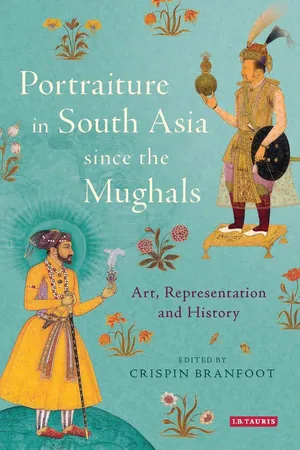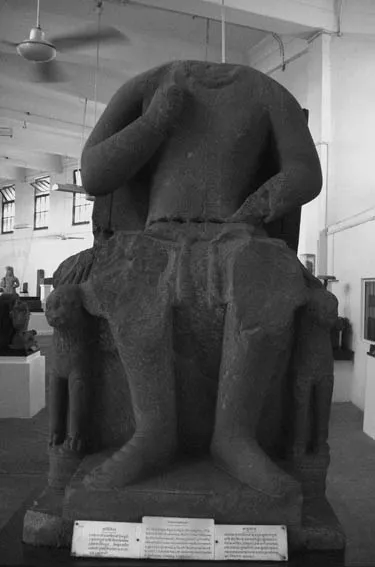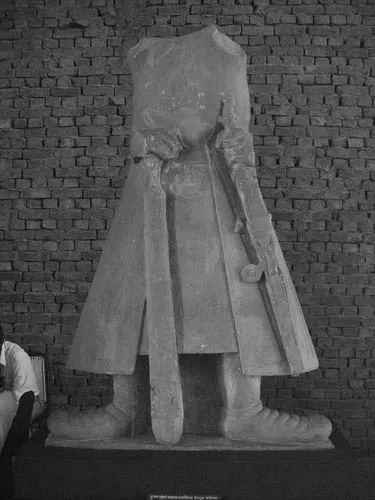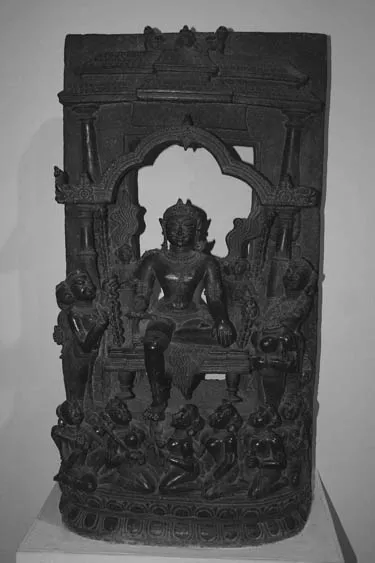![]()
CHAPTER 1
PORTRAIT OR IMAGE?
Some Literary and Terminological
Perspectives on Portraiture in
Early India
Vincent Lefèvre
As any museum-goer knows, portraiture is one of the main fields of art history.1 It is then all the more surprising to see that general studies of this artistic genre are rather rare; and most of them emphasise the portrait in the West. It is often said, or at least implied, that portraits do not really exist in non-Western civilisation, with a few exceptions. Mughal India and the following period is among them, as is evident from the papers gathered in this volume. As for pre-Mughal India, it has long been thought that portraiture simply did not exist. For instance, the famous historian Vincent A. Smith wrote that ‘well-authenticated portrait statues [were] rare in India’2 and, according to him, it was due to a ‘Hindu disinclination to or aversion from realistic likeness’.3 More balanced, Stella Kramrisch wrote: ‘Portraiture, in the current sense, does not exist in Indian sculpture. Portraiture belongs to civilizations that fear death. Individual likeness is not wanted where it suffices for the type to continue.’4
However, things have changed more recently for two different reasons. On the one hand, regional and/or chronological studies dealing with specific aspects of Indian art have demonstrated that portraits were not as ‘rare’ as it was long thought. On the other hand, the conceptual approach to portraiture has evolved and it is no longer automatically equated with ‘realistic’ or ‘naturalistic physiognomic likeness’, though this idea remains quite common.
Before examining a few ideas about portraiture in pre-Islamic India, it is then necessary to specify what I mean by ‘portrait’. On the whole, I follow Richard Brilliant's definition: ‘Simply put, portraits are art works, intentionally made of living or once living people by artists, in a variety of media, and for an audience.’5 This is indeed a wide definition, but I think it is a good one since it does not hide the fact that ‘portrait’ is a conventional word, behind which many realities and specificities can exist and, sometimes, coexist. It also implies that, as an artwork, it is not an objective notion and has to be interpreted. At the same time, I think that portraiture is a relative notion. For the sake of clarity, I would like to take the example of an extremely famous artwork, though it is not related to Indian art, Auguste Renoir's painting The Luncheon of the Boating Party (Le Déjeuner des canotiers). This work, painted in 1880–1 and now in the Phillips Collection, Washington, is usually considered a ‘genre painting’ since it depicts a typical moment in Parisian life at the end of the nineteenth century. But we know that this was inspired by the parties organised by Renoir and some of his friends at the Auberge Fournaise at Chatou, near Paris. In this regard, all the characters depicted here can be more or less identified: Aline Renoir and Gustave Caillebote in the foreground, Charles Ephrussi discussing with Jules Laforgues at the back, etc., while Renoir himself may have painted his self-portrait as the man in profile in the middle near the drinking woman (this point is however debatable). Therefore, though this is not very common, this painting could also be deemed as a ‘group portrait’, depending on the way we look at it.
Conversely, imaginary images can also be considered as portraits when they fulfil their function. This is the case, for instance, of the popes' gallery at San Paolo-fuori-le-Mura basilica in Rome, where real likenesses of more or less recent popes are next to images of popes the features of whom are totally unknown, when they are not themselves completely imaginary. Be it as it may, the status of all the images is the same.
To complete Brilliant's above definition, I would say that an ‘image’, either flat or in the round, is to be considered as a ‘portrait’ according to three criteria: intention, perception, function. By ‘intention’, I mean that the artist/craftsman and/or his patron have deliberately chosen to represent, in one way or another, a specific and historically attested person. By ‘perception’, I assume that in order not to be an anonymous image, a portrait must be acknowledged as such by the viewer; this can be obtained through a visual examination or a written statement.6 Incidentally, it means that what may at first have been conceived as ‘portrait’ may become, if it is not identified, a simple ‘image’. Finally, by ‘function’, I imply that, technically speaking, a ‘portrait’ is an ‘image’ like any other but that its specificity relies on the way it is used. With these three criteria in mind, it then becomes much easier to recognise several portraits in early Indian art.
The Prevalence of Portraiture in Early India
In the catalogue of the exhibition The Indian Portrait, Robert Skelton states that ‘if portraits are defined as recognizable images of known human individuals, then all that remains from the earlier periods of Indian art are stories about them rather than real work of art’ and then introduces some very interesting narratives.7 I would agree with Robert Skelton if we consider a portrait to be a physiognomic likeness. Portraits comparable to those produced during the Mughal and the Rajput periods do appear in early Indian literature but have rarely survived. This is hardly surprising since most of the portraits mentioned in stories and dramas are painted on perishable materials, like wooden tablets (chitraphalaka).
However, if we define portraiture according to the three criteria I have just mentioned above, then it becomes clear that portraits are ubiquitous in ancient and mediaeval India. We can find them in a variety of media and I will mention just a few examples to give an idea of how extant the phenomenon is, restricting myself to cases which do not create too much debate.8 The Kushan kings were among the first to have their portraits on their coins in the early centuries CE, followed by the Guptas and many other dynasties. At Mat near Mathura, stone statues representing Vima Kadphises (Figure 1.1) and Kanishka (Figure 1.2) have been unearthed; another portrait of Kanishka has been discovered at Surkh Kotal, in Afghanistan, while the famous Rabatak inscription informs us of the existence of a third statue.9 Other rulers were represented in metal, like the queens Sembiyan Mahadevi10 or Cholamahadevi or king Kulottunga III, all of the South Indian dynasty of the Cholas.11 Sometimes, they were portrayed directly on the temple walls, in reliefs of varying scale and depth: examples include Gandaraditya at Konerirajapuram, Rajaraja I at Tiruvisalur,12 or several representations of Narasimha I Ganga at Konarak (Figure 1.3). The early sixteenth-century Vijayanagara emperor Krishnadevaraya was portrayed both in bronze and in stone relief (Figure 1.4); both images look quite different from each other.13
Most of the time, an inscription enables us to identify the portrayed person, and by comparison we can infer that other images without any inscription are also portraits. However, kings and queens are not the only persons to be depicted and, when one pays attention, one can find numerous depiction of donors and devotees. They are quite stereotyped but they are nevertheless representation of ‘known human individuals’. For example, the Gupta-period Buddha from Jamalpur (Mathura) was donated by monk Yashadinna who is probably the small figure at the feet of the Buddha.14 Or we might mention the bronze figure of the Shahi king Vikramaditya Nandi, blessed by the Buddha, and dated 714 CE.15
Figure 1.1 Vima Kadphises. Mat, Mathura, Uttar Pradesh, second century CE. Sandstone, 209 cm. Government Museum, Mathura. Photo: Vincent Lefèvre.
Textual evidence is thus very important to distinguish a portrait from an image; in other words, it is necessary to make the ‘intention’ clear so that ‘perception’ becomes possible. But, as we know, Indian literature has always favoured the indirect mode of expression, what the poets call vakrokti. Likewise, visual arts display many examples of allusion. It means that sometimes portraits can be recognised through analysis, though they do not appear as such at first glance. I would call them ‘allegorical portraits’. For instance, the famous Varaha panel at Udayagiri can be interpreted as a metaphorical portrait of Chandragupta II, though the king may be portrayed more directly in the small beheaded devotee kneeling at the feet of the god.16 A similar figure also appears on the same site at the feet of the reclining Vishnu, a panel which is linked, both iconographically and ritually, to the Varaha one. Michael Rabe has similarly proposed to identify Narasimhavarman Pallava along with his father and grandfather in the group of ascetics on the Great Penance panel at Mamallapuram.17 Finally, portraits can even be hidden in what I would call ‘double-meaning images’ such as the Shiva Gangadhara/ Mahendravarman from the Lalitankura cave at Trichy. This is the counterpart of the shlesha stylistic device in literature, and shlesha is very important in the inscription accompanying the panel.18
Figure 1.2 Kanishka. Mat, Mathura, Uttar Pradesh, second century CE. Sandstone, 148 cm. Government Museum, Mathura. Photo: Vincent Lefèvre.
Figure 1.3 Narasimha on a swing. Konarak, Orissa, thirteenth century. Chlorite, 87×46.5 cm. National Museum, New Delhi. Photo: Vincent Lefèvre.
Figure 1.4 Krishnadevaraya. North gateway of the Nataraja temple, Chidambaram, Tamil Nadu, early sixteenth century. Photo: Vincent Lefèvre.
Literary Testimonies and Vocabulary
Now, it is time to return to the literary evidence to propose a terminological study, first, because it can give us some clues about the prevalence of portraiture but also because it may indicate the way(s) these portraits were conceived and interpreted by their contemporaries. When reading many narratives, we are more or less forced to note a sort of discrepancy with the images mentioned so far; indeed, these images seem to be rather stereotyped, or at least stylised, whereas portraits in dramas and narratives are exact likenesses. Many scholars have been uncomfortable with this and have argued that such real likenesses never existed in Indian art. We could of course address this issue at length, but in brief I find it difficult to explain away the literary evidence, because I do not see how poets and dramatists could have made such widespread use of a device which would have been totally unknown to their audience. To my ...




